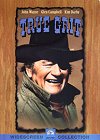True Grit (1969)
| John Wayne had starred in more than 130 movies by the time he won the 1970 Academy Award for Best Actor for his role as the overweight, aging, one-eyed, surly, hard-drinking Federal Marshal Reuben J. "Rooster" Cogburn in "True Grit." Starting as an extra in bit roles in the 1920s, moving through dozens of B-Westerns in the 1930s, and finally entering stardom and taking his place as an American icon in John Ford Westerns and patriotic World War II films throughout the 1940s and 1950s, Wayne's career was as multifaceted as it was impressive in its sheer size and range. This is why his Oscar for "True Grit," which was awarded over both Dustin Hoffman and Jon Voight's performances in "Midnight Cowboy" (1969), can be seen less as an award for his particular role in "True Grit," and more as a lifetime achievement award, given to a man who helped establish the motion picture industry as a true dream factory. This is not to say that Wayne's performance in "True Grit" is not award-worthy in and of itself (although many would argue that he truly deserved the Oscar for his swan song performance in 1976's "The Shootist," which was about an aging gunslinger dying of cancer at the turn of the 20th century). The role of Rooster Cogburn in "True Grit" was certainly one of Wayne's best performances, impressive in both his creation of a larger-than-life screen presence and the nuances he gave the role in all the right places. If Wayne can be faulted as an actor, it is usually in his lack of subtlety; being that his career was made up largely of epic war film and Westerns, being larger-than-life was a way of life for the Duke. One of the nice things about his role in "True Grit" is that it allowed him range. Granted, there are cartoonish moments of buffoonery, such as when he's so drunk he literally falls off a horse, and obvious moments of fearless heroism that could only take place in the movies. But, then, there are also the smaller, touching moments, such as the look on the family-less Rooster's face when a young woman offers him the spot next to hers in her family cemetery. While Wayne is the star, in many ways "True Grit" belongs to then 22-year-old Kim Darby, who starred as the teenager Mattie Ross, a headstrong, willful young woman who hires Rooster to hunt down and capture Tom Chaney (Jeff Corey), the man who killed her father and stole her family's fortune. Rooster has an added incentive to track down Chaney because it is rumored he is running with a bandit named Ned Pepper (Robert Duvall in an early role), who Rooster has being trying to catch for years. The story takes place post-Civil War in Arkansas, and even though it is not explicitly narrated by Mattie as it was in the original novel by Charles Portis, there is still the sense that we see the story unfolding from her point of view. With her Mia Farrow-ish cropped hair and bright eyes, Darby looks almost out of place in the rough world of the Western ... until she opens her mouth, that is. Mattie is determined and frank; she doesn't mince words or soften her tone, which is why she can last with the likes of a cantankerous old warrior like Rooster. There is one scene in particular that stands out in defining Mattie's character, in which she verbally dukes it out with Colonel G. Stonehill, a smarmy horse trader (played by Strother Martin, who was so good as the warden in "Cool Hand Luke") in order to get her father's money back. Stonehill obviously thinks that this little girl poses no threat, but Mattie is so intimidating in her sheer willfulness and refusal to give up that he caves to her every demand, even when she returns and wants to buy back one of her father's horses for less than half Stonehill had paid for it that very morning. Like many Westerns, "True Grit" takes the form of a journey. This particular journey is undertaken by Rooster, Mattie (who refuses to be left behind), and a young, somewhat naive Texas Ranger with the unlikely name of La Boeuf (Glen Campbell), who is also hunting Tom Chaney because he apparently murdered a state senator and the senator's dog back in Waco, Texas. The journey narrative allows for many things: Visually, it allows for plenty of stunning photography (the cinematography is by Lucien Ballard, the consummate pro who also shot most of Sam Peckinpah's films). Narratively, it allows for the characters to interact and grow. The character dynamics among Rooster, Mattie, and La Boeuf are strained at best when the journey begins, but you can rest assured that, by the end, they will have grown beyond their differences. "True Grit" was directed by Henry Hathaway, an old pro who had already helmed films in every conceivable genre, including seven previous collaborations with Wayne. Hathaway was a no-nonsense Hollywood director, short on style but long on fluidity and clarity. "True Grit" is mostly a character study for the first two-thirds of its running length, and it is only in the last 30 minutes that it turns into a truly rousing adventure story. Interestingly, while the action scenes are well staged and exciting, in a film that had, until the end, been fueled by characters, the action feels somewhat forced, as though the narrative could not survive unless it featured at least a few major gunfights and someone falling into a cave filled with rattlesnakes. It is almost as though Wayne's star persona simply could not withstand antiheroism for an entire film (although he was no stranger to playing an antihero, most notably in "The Searchers). But, still, at some point he must gallop off into a fight in which he is outnumbered four to one, two guns blazing at once. Of course, one the strongest aspects of "True Grit" is that it never takes itself too seriously. The entire film is infused with low-key and sometimes outright humor, and there is the lasting impression that Rooster was designed and executed as a subtle parody of Wayne's entire career. "True Grit" appeared at a time in which the classic Western was dying. In fact, the year it was released, 1969, might be noted as the official death of the classic American Western, as it was the year of both the decidedly depressing modern Western "Midnight Cowboy" and Peckinpah's bloody ode to antiheroism, "The Wild Bunch." Nevertheless, "True Grit" is an enjoyable throwback to the heydey of '50s Westerns, and it will certainly be remembered as one of Wayne's brightest moments in film. THE DISC Widescreen: 1.85:1 Video: The new anamorphic widescreen (1.85:1) transfer is quite good. The most impressive scenes are the long shots of the landscape, where the vast Technicolor palette used by cinematographer Lucien Ballard--from the gray, snow-capped mountains to the autumn-colored trees to the electric blue sky--is rendered very nicely. Color saturation is generally good, although there are a few instances of apparent fading. The image is sharp, although there are a few sequences that seem fuzzier than others, and it is free of any nicks, scratches, or dust, which often mar prints of films that are more than 30 years old. There were few signs of artifacting, and all the flesh tones appeared natural. Audio: The audio is Dolby Digital mono, which is surprisingly effective, even in its limited aural range. Everything sounds clear, and dialogue is always audible. Elmer Bernstein's somewhat overwrought musical score is especially notable for how deep it sounds. Extras: Unfortunately, the disc lacks any extras outside of the original theatrical trailer. Copyright © 1999,2000 James Kendrick |
Overall Rating: 

 (3)
(3)


